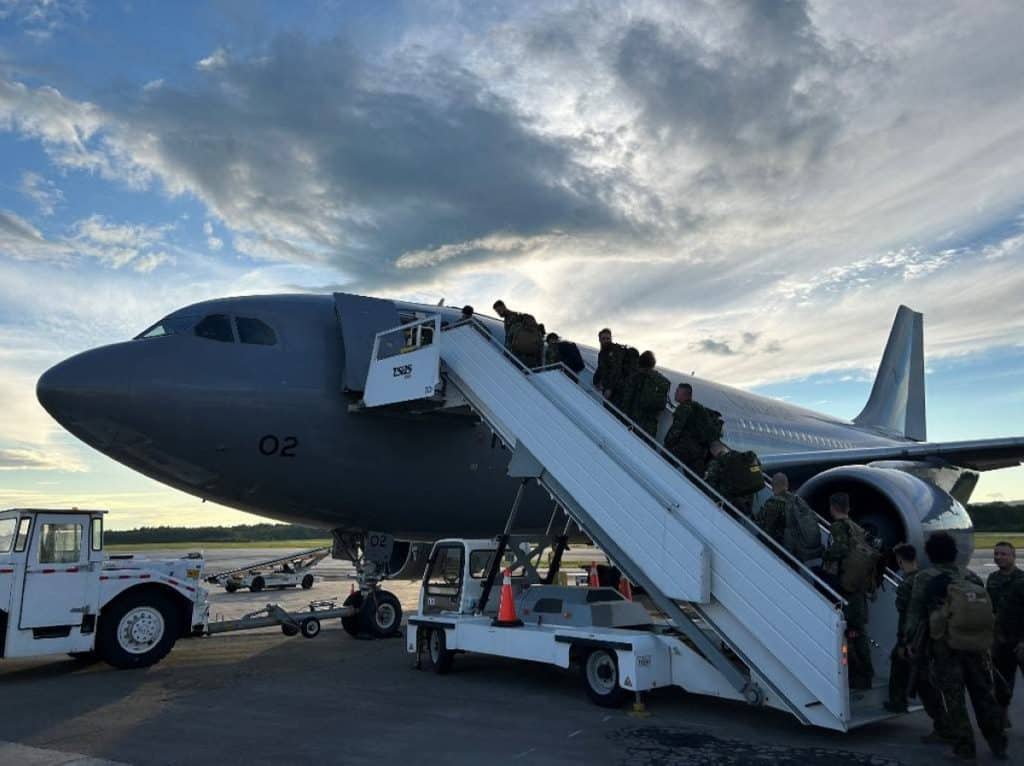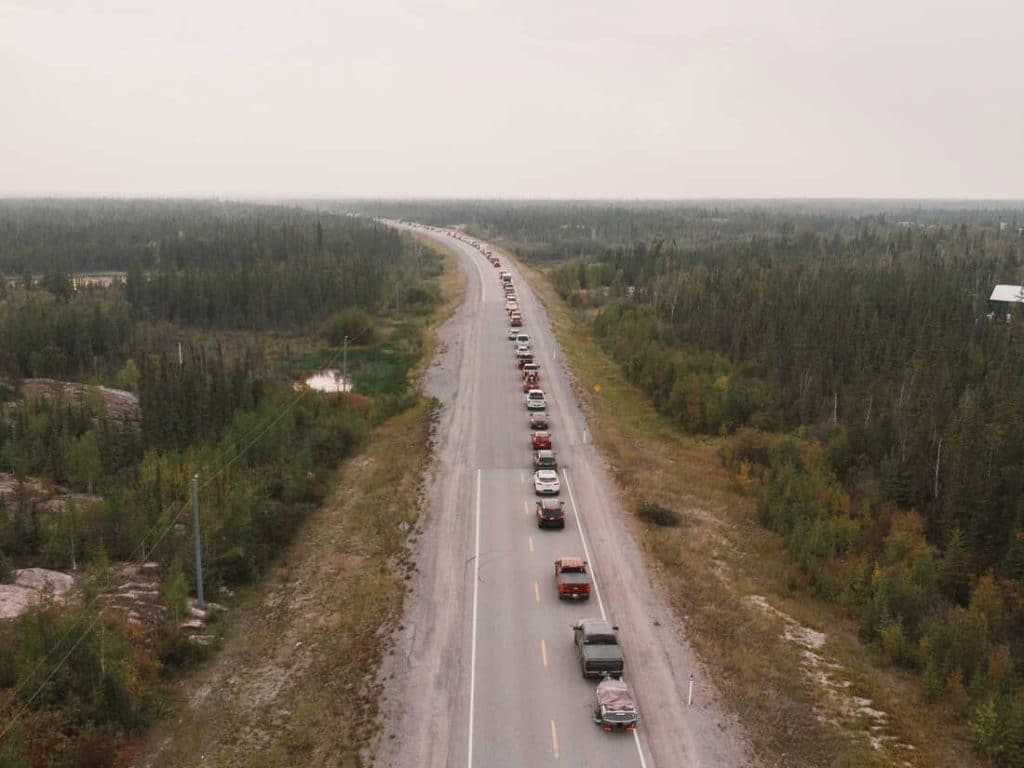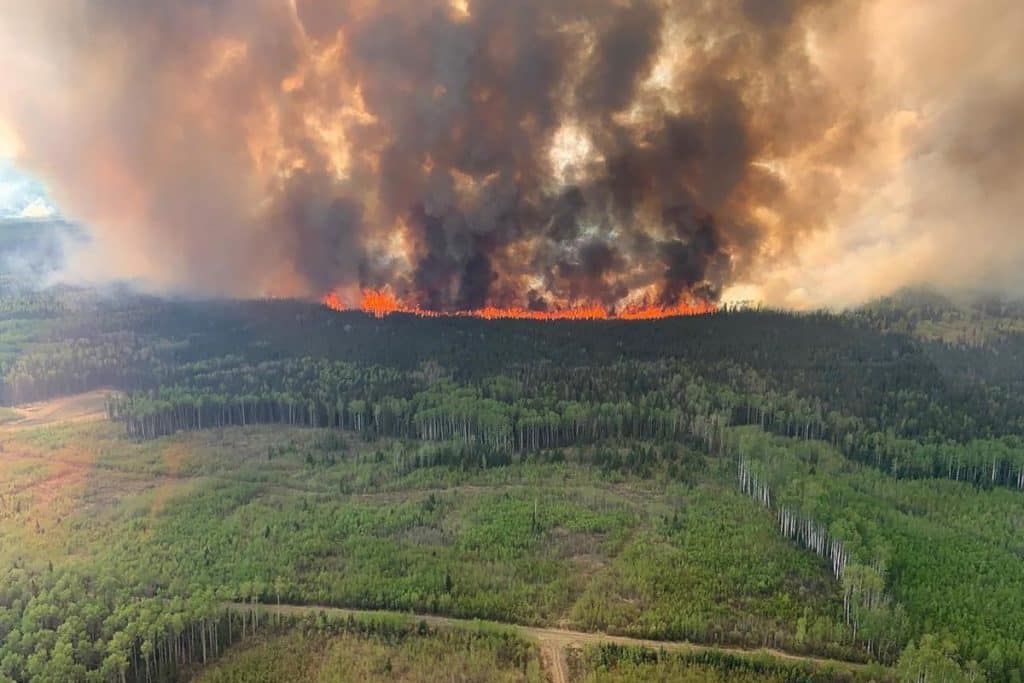News
Wildfire in Canada’s Northwest Territories Force 20,000 to Flee Yellowknife
On Thursday, Canadian fire firefighters fought to keep wildfires from reaching the northern city of Yellowknife, where all 20,000 residents are fleeing by car and plane following an evacuation order.
Water bombers flew low over Yellowknife, the capital of the vast and thinly populated Northwest Territories, as dense smoke enveloped the city. Officials say the slow-moving fire is currently 15 kilometres (10 miles) northwest of the city and might reach the outskirts by Saturday if no rain falls.
“Very tough days ahead, with two days of northwest to west-northwest winds on Friday and Saturday, which would push fire towards Yellowknife,” the territorial fire department stated in a Facebook post.
Officials in the Pacific province of British Columbia, which has seen particularly strong fires this year, have advised citizens to brace themselves for dangerous fire conditions.
“This weather event has the potential to be the most challenging 24 to 48 hours of the summer from a fire perspective,” wildfire service director Cliff Chapman told reporters. “We anticipate significant growth and resource challenges from north to south.”
Hundreds of people waited outside a local high school in Yellowknife to be escorted to the airport for one of five evacuation flights scheduled for Thursday to the neighbouring province of Alberta.
On Thursday, Prime Minister Justin Trudeau summoned a meeting of the Incident Response Group to discuss the fires. In times of crisis, the group of senior officials and ministers gathers.
Defence Minister Bill Blair told the Canadian Broadcasting Corporation (CBC) following the meeting that the federal government was closely watching the evacuations and was ready to immediately transport residents if land routes become impassable.
With over 1,000 active fires blazing across the country, including 265 in the Northwest Territories, this is Canada’s worst-ever wildfire season. According to experts, climate change has increased the wildfire situation.
According to officials, drought has contributed to the volume and intensity of this year’s fires, with high temperatures worsening the problem. Much of Canada has had unusually dry conditions.
The evacuation order was issued late Wednesday, according to Shane Thompson, the territory environment minister, to give people time to get out before the weather turned terrible.
“The urgency is, fire changes drastically… right now, the conditions are in our favour, but that will change on Saturday,” he told Reuters.
He estimated that around 65% of the Territories’ population of 46,000 people would be evacuated.
The infrastructure of the Northwest Territories is inadequate, with only one two-lane road connecting Yellowknife to the province of Alberta to the south. Alberta has set up three official evacuee welcome centres for individuals evacuating by vehicle, but the nearest is about 1,100 kilometres (680 miles) away in Yellowknife.
Residents must evacuate Yellowknife by noon on Friday (1800 GMT).
Yellowknife Mayor Rebecca Alty said special crews were clearing trees near the city to prevent the fire from spreading. They also intended to apply fire retardant while checking sprinkler systems, she told the CBC.
Following social media outcry over some skyrocketing costs, Canada’s two main airlines said they were adding flights from Yellowknife and capping fares.
Some of those who have been evacuated will be transported to Calgary, Alberta. Calgary’s emergency management director, Iain Bushell, stated that the city could house and feed 5,000 people.
“We are prepared to house them and help them for as long as they need,” he said during a televised briefing.
The Northwest Territories fire department stated on social media that a fire that had been threatening Hay River, a settlement of about 3,000 people on Great Slave Lake further south, had halted overnight.
So far, around 134,000 square kilometres (52,000 square miles) of land in Canada has been burnt, which is more than six times the 10-year average. This season, about 200,000 people have been forced to leave.
“The territories have never seen anything like this in terms of wildfire before… it’s an unimaginable situation for so many,” said Mike Westwick, the territories’ fire information officer, to the CBC.
The fires have also had an impact on industrial and energy output. De Beers said in a statement that its Gahcho Kue mine, some 280 kilometres (170 miles) northeast of Yellowknife, was still operational despite the evacuation of a number of personnel from local villages.
In May 2016, a massive fire burned 10% of the structures in Fort McMurray, Alberta’s northern energy-producing city, forcing the evacuation of 90,000 residents and shutting down more than a million barrels of oil output.
90% of the structures in the British Columbia community of Lytton burned down in June 2021, a day after it recorded Canada’s hottest-ever temperature.
Canada has spent more on battling and suppressing wildfires than on sustaining its firefighting people and programme since 2009.
News
Britain Must Be Ready for War in 3 Years, Warns New Army Chief

The new head of the Army has stated that Britain must be prepared to fight a war within three years.
Gen Sir Roland Walker has issued a warning about a variety of risks in what he calls a “increasingly volatile” environment.
However, he stated that war was not inevitable and that the Army had “just enough time” to prepare to prevent conflict.
He stated that the Army’s fighting capacity would be doubled by 2027 and tripled by the end of the decade.
Gen Walker warned that the Britain was under threat from a “axis of upheaval” in his first speech as Prime Minister on Tuesday.
Among the primary concerns confronting the Britain in the next years, as noted by the general in a briefing, is an enraged Russia, which may seek vengeance on the West for helping Ukraine, regardless of who wins the war.
He stated: “It doesn’t matter how it finishes. I believe Russia will emerge from it weaker objectively – or completely – but still very, very dangerous and seeking some form of retaliation for what we have done to assist Ukraine.”
Britain’s Government Defence Review and Military Challenges
He also warned that China was determined to retake Taiwan, and Iran was likely to seek nuclear weapons.
He stated that the threats they posed may become particularly acute in the next three years, and that these countries had formed a “mutual transactional relationship” since the war in Ukraine, sharing weaponry and technology.
However, he stated that the path to conflict was not “inexorable” if the UK re-established credible land troops to assist its deterrent strategy for avoiding war.
In his speech, he described his force of slightly over 70,000 regular troops as a “medium-sized army” and made no direct call for additional resources or men.
However, he pushed the British Army to adapt swiftly, focussing on technology such as artificial intelligence and weaponry rather than numbers.
His ultimate goal is for the Army to be capable of destroying an opponent three times its size.
This would entail firing quicker and farther, he said, aided by lessons learnt from the Ukraine war.
The general’s speech at the Royal United Services Institute land warfare conference comes only one week after the government began a “root and branch” defence review to “take a fresh look” at the challenges facing the armed services.
Defence Secretary John Healey launched the assessment, describing the existing status of the armed forces as “hollowed-out” and stating that “procurement waste and neglected morale cannot continue”.
According to the most recent Ministry of Defence (MoD) numbers from April 2024, the Britain’s regular Army forces total 75,325 troops (excluding Gurkhas and volunteers).
That figure has been declining in recent years, as recruiting has failed to match retention. The previous Conservative administration lowered the planned headcount from 82,000 to 72,500 by 2025.
Members of the NATO military alliance have agreed to spend at least 2% of GDP on defence by 2024, but several countries are unlikely to fulfil this goal.
The Britain presently spends 2.3% of its GDP on defence. Prime Minister Sir Keir Starmer has previously stated that the defence review will include a “roadmap” for increasing this to 2.5%, however he has yet to provide a date for this promise.
Source: BBC
News
Katie Ledecky Hopes For Clean Races At Paris Olympics In The Aftermath Of The Chinese Doping Scandal

PARIS — Katie Ledecky is looking for clean Olympic races. On Wednesday, Hope had pretty much reached her limit.
The American swimmer hopes to add to her six gold medals as she competes in the 400, 800, and 1,500 meters at the Paris Games. Her program starts with the heavy 400 on Saturday, featuring Ariarne Titmus and Summer McIntosh.

Katie Ledecky | ESPN Image
Katie Ledecky Hopes For Clean Races At Paris Olympics In The Aftermath Of The Chinese Doping Scandal
The 27-year-old Katie is competing in her fourth Summer Olympics, but the first since a doping scandal involving almost two dozen Chinese swimmers who tested positive for a banned chemical before the Tokyo Games — yet were permitted to compete with no consequences. The controversy has raised serious worries regarding the effectiveness of anti-doping initiatives.

Katie Ledecky | Vogue Image
“I hope everyone here is going to be competing clean this week,” Ledecky claimed. “But what truly counts is, were they training cleanly? Hopefully this has been the case. Hopefully, there has been worldwide testing.”
The International Olympic Committee has expressed concern over the ongoing US investigation into possible doping by Chinese swimmers. While awarding the 2034 Winter Olympics to Salt Lake City on Wednesday, the IOC urged Utah officials to do whatever they could to stop the FBI investigation.
“I think everyone’s heard what the athletes think,” Katie added. “They seek transparency. They want more answers to the remaining questions. At this point, we are here to race. We are going to race whoever is in the lane next to us.
“We are not paid to conduct the tests, so we trust those who follow their regulations. That applies both today and in the future.

Katie Ledecky | ESPN Image
Katie Ledecky Hopes For Clean Races At Paris Olympics In The Aftermath Of The Chinese Doping Scandal
SOURCE | AP
News
London Heatwave Alert: High Temperatures Set to Soar to 29C Next Week

As the summer holidays begin, London may experience an official heatwave with temperatures reaching up to 29 degrees Celsius.
The Met Office predicts a long period of sunny and dry weather for London after a soggy spring and summer.
After a cloudy day on Saturday, temperatures are expected to reach 27C on Sunday, with lots of sunlight.
On Monday and Tuesday, temperatures are forecast to peak at 29 degrees Celsius. Monday is forecast to offer more sunlight, while Tuesday may see some gloomy weather.
Temperatures are expected to remain in the high 20s next week, with lows of approximately 18C.
According to the Met Office, a heatwave is “an extended period of hot weather relative to the expected conditions of the area at that time of year, which may be accompanied by high humidity.”
In the United Kingdom, a heatwave is proclaimed when daily temperatures meet or surpass a certain level for at least three consecutive days.
In London, the heatwave threshold is 28 degrees Celsius.
The Met Office reported that the UK is experiencing hotter and wetter weather on average due to climate change.
The UK experienced its warmest May and April on record this year, despite damp and dismal conditions in many areas.
According to the Met Office’s State Of The UK Climate 2023 report published on Thursday, the UK experienced historic levels of extreme weather last year.
In the United Kingdom, 2023 was the second warmest year on record, bringing storms, flooding, strong heatwaves, and rising sea levels; only 2022 was warmer.
It was 0.8°C higher than the average from 1991 to 2020, and 1.66°C higher than the 1961 to 1990 average.
However, 2023 will be a “cool year” in comparison to 2100, based on the planet’s warming trajectory.
The government’s plan to adapt to the hazards presented by climate change is currently being challenged in the High Court by campaigners who allege the Tory administration’s July 2023 National Adaptation Programme (NAP) fails to adequately address 61 concerns.
Source: The Standard
-
World2 weeks ago
Former President Trump Survives Being Shot at Pennsylvania Rally
-
Tech4 weeks ago
Huawei Launches 5G-A Pioneers Program at MWC Shanghai 2024: Paving the Way for a Connected Future
-
Tech4 weeks ago
ChatGPT Answers Undiscovered Questions and Outperforms Students.
-
Sports4 weeks ago
NBA Draft: Kyle Filipowski Withdraws Unexpectedly From The First Round
-
News4 weeks ago
US Supreme Court Rejects Drug Deal that Protects the Sackler Family
-
Health4 weeks ago
US Health Agency Issues Dengue Virus Infection Warning





















